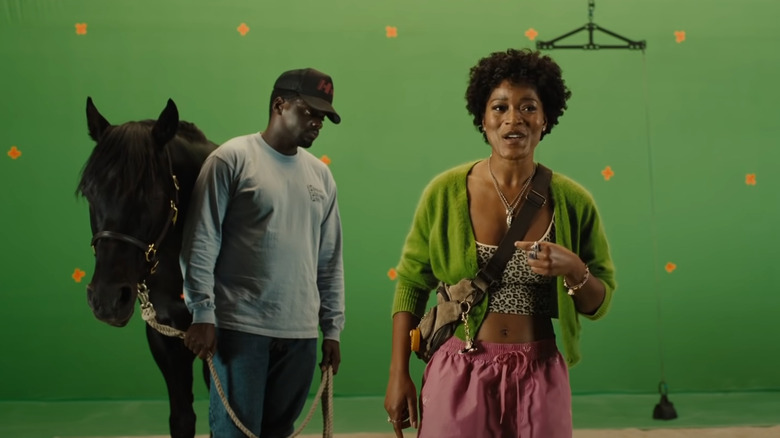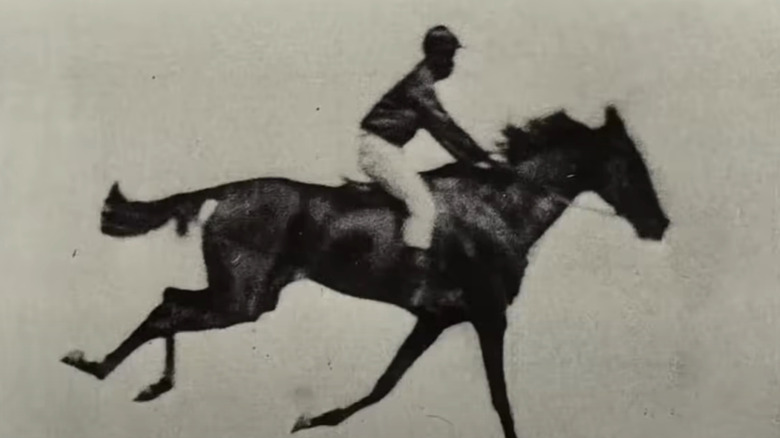How Accurate Is The History Of The Haywoods' Ancestor In Nope?
Spoilers ahead for "Nope."
Movies and motion pictures set both the groundwork for Jordan Peele's "Nope," the many small details, and its ultimate goal. The movie follows the Haywood family — specifically the siblings OJ (Daniel Kaluuya) and Em (Keke Palmer) — and it is established quite early in the film that they are the descendants of the person in one of the very first proto-films, the succinctly named "Horse in Motion," which is a brief clip of a man riding a horse. They are told this by their father Otis (Keith David), who happens to own a ranch that rents out horses to movie studios. Unfortunately, Otis is killed by a mysterious force, and ownership of Haywood's Hollywood Horses falls to the siblings.
Upon realizing that these events are way beyond normal understanding and comprehension, Em and OJ seek to capture on film exactly what is going on in the remote area surrounding the ranch (and a nearby amusement park). Finding out that normal electronic means of surveillance and video capturing are unable to film the deadly and otherworldly being, the siblings eventually turn to a hand-cranked camera to circumvent the electronic interference of the being they name Jean Jacket, which completes a thematic circle which started with their ancestor, the very first person ever filmed, and their own movie, which will be the very first proof of whatever-the-heck Jean Jacket is.
However, how accurate is the story of "Horse in Motion" in relation to "Nope?"
The very first motion picture was created with a series of cameras in 1877
The true story of how "Horse in Motion" came to exist is one that almost sounds like bet made in a bar.
According to Britannica, British American photographer Eadweard Muybride, who developed a means in which to take a series of photographs, was tapped by California Governor Leland Stanford, an enthusiastic horse breeder. At the time, there was great speculation regarding the question if, at any point when a horse is running, all of its hooves leave the ground simultaneously — a subtlety too fast for the human eye to detect, hence the debate. Ingeniously, in 1877, Muybridge set up a series of cameras along a racetrack with wires stretched across and connected to the individual shutters. As the horse and jockey raced the span, their advance would trigger the cameras at different points, and the accumulated and staggered photographs created what was, essentially, the first motion picture.
As reported by Smithsonian Magazine, the question as to whether horses ever completely leave the ground was known as the "unsupported transit theory," but Muybridge's efforts with photography helped prove that horses do completely leave the ground. Professor Marta Braun of Ryerson University told the publication, "We have to remember that the horse was the source of all locomotion of importance. You went to war on horses, and any kind of large-scale movement was done on horses. To understand it was really very critical."
Yet, what do we know about the rider in "Horse in Motion," as opposed to the technology and the horse?
Nope is making a point with its fiction, based on a historical truth
Within the context of "Nope," Otis says that their ancestor who appeared in "Horse in Motion" was named Alistair Haywood, their ancestor. Indeed, in real life, the name of the writer is unknown, so Jordan Peele took some creative liberty with this fact to support the themes of "Nope."
According to Newsweek, the official name for "Horse in Motion" is actually "Sallie Gardner at a Gallop," and the name of Gardner actually refers to the horse in question, and not the rider. The rider is best identified by the cabinet card versions of the photographs, and the name proudly displayed on them is "G. Domm." Unfortunately, little is known about this rider, but speculation often points to one Gilbert Domm as one of the stable hands at the ranch where the pictures were taken.
The publication then goes on to say that the race of the person in "Horse in Motion" is somewhat hard to pin down, on account of a silhouette-like effect used to better highlight the movement of the horse, but Peele did use archival and pieced-together footage of a Black man on a horse from Muybridge's book, Animal Locomotion, from 1887. This series of photographs is called, "Horses. Gallop; thoroughbred bay mare (Annie G) with male rider, 1872-1875." This creates even more ambiguity, because this rider is completely unknown to history.
With all this in mind, it's clear that Peele really, really knows about the history of cinema, and he cleverly exploited real historical gaps to create a family that has a deep connection to the profession. Despite the fact the Haywood family is fictional, there is a chance that someone's real life ancestor is one of the first unsung Black actors who helped bring the technology of movies to the forefront.


